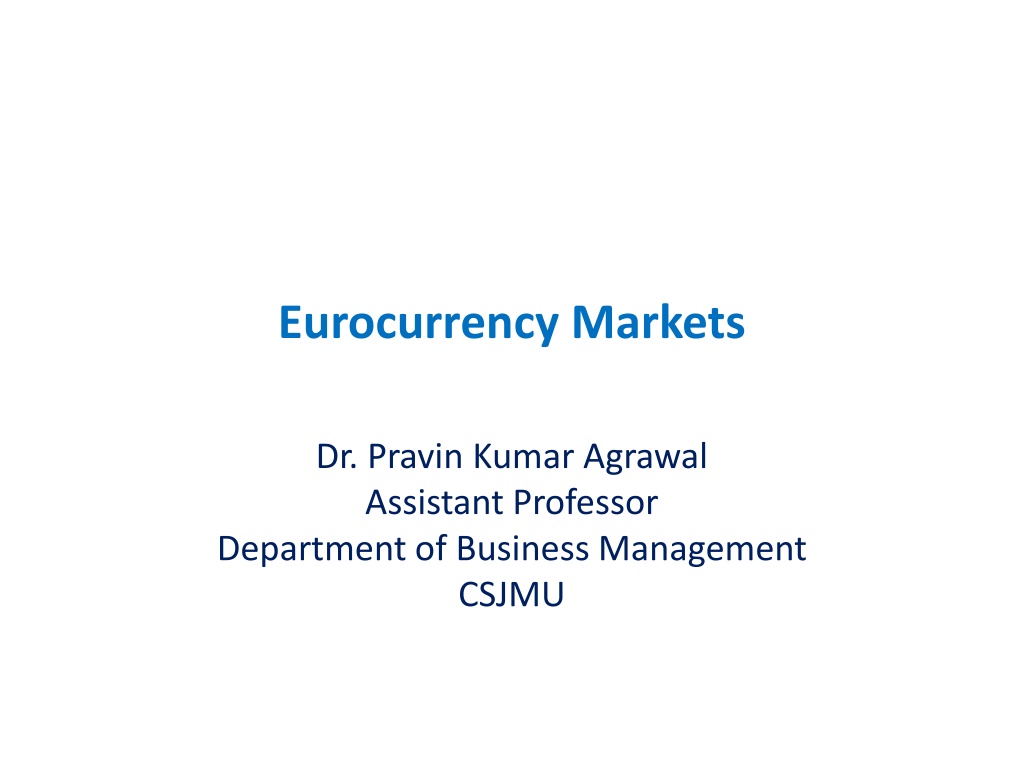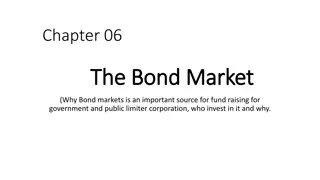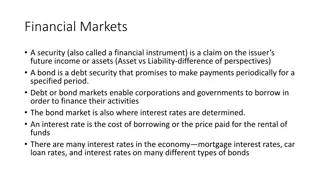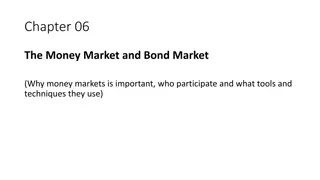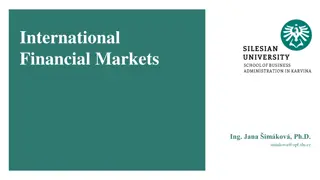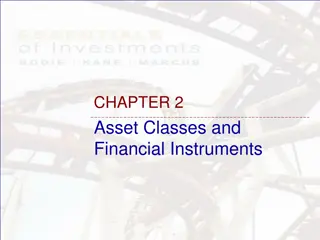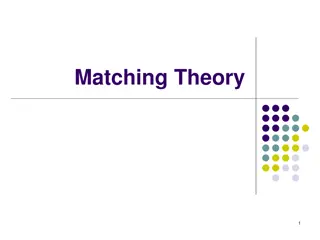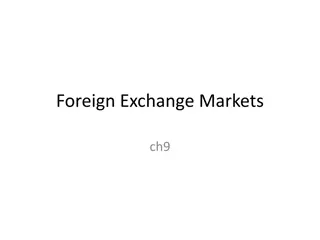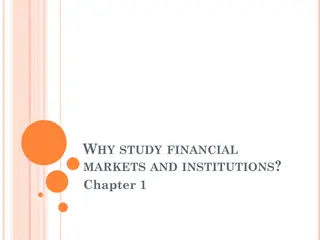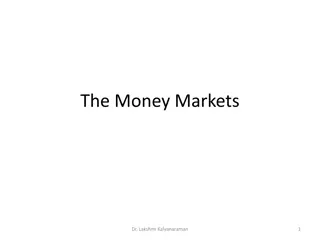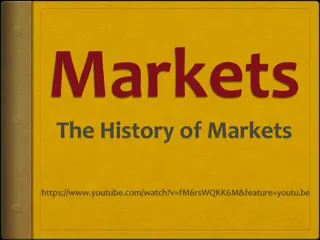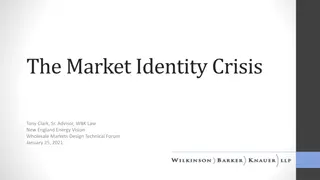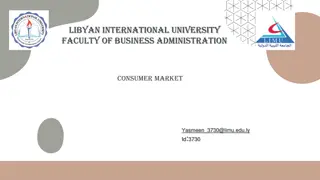Understanding Eurocurrency Markets: A Comprehensive Overview
Eurocurrency markets facilitate the deposit and loan of currencies outside their country of origin. This includes Eurodollars, Eurosterlings, and other freely convertible currencies. These markets involve banks worldwide and play a key role in international trade and capital flow. Eurobanks are major players in this market, offering diverse banking services including Eurocurrency transactions.
Download Presentation

Please find below an Image/Link to download the presentation.
The content on the website is provided AS IS for your information and personal use only. It may not be sold, licensed, or shared on other websites without obtaining consent from the author. Download presentation by click this link. If you encounter any issues during the download, it is possible that the publisher has removed the file from their server.
E N D
Presentation Transcript
Eurocurrency Markets Dr. Pravin Kumar Agrawal Assistant Professor Department of Business Management CSJMU
Eurocurrency Markets Eurocurrency markets are markets for both deposits and loans currencies, other than that of the country in which they are located. in a currency, or
Eurocurrency Any freely convertible currency deposited in a bank outside its country of origin. Pounds which are deposited in US become eurosterling, dollars deposited in London become Eurodollars. These deposits can be placed in a foreign bank or in a foreign branch of a domestic US bank. Any convertible currency can exist in Euro e.g. we can have Eurosterlings, Euroyen, Eurodollars and so on. Contrary to its name, the term does not refer to euros that are deposited outside of Europe.
Eurocurrency For example, if you deposit Japanese yen at a bank in the United States, it is considered to be Eurocurrency.
Euro is a currency and Eurocurrency is deposits and loans in various currencies, including Euro?
They all share the Euro-dollar characteristic and are national currencies deposited outside their own border. In addition to Europe, financial institutions in the Bahamas, Cayman Islands, Panama (tax heaven), Canada, HK, Japan, Singapore and US IBFs (International Banking Facilities-off shore banking) deal in Eurocurrencies.
Eurocurrency Markets The Eurocurrency market consists of those banks which accept deposits and make loans in foreign currencies. The Eurocurrency market allows for more convenient and flexible borrowing which improves the international flow of capital for the purpose of trade between countries and companies.
Example A company in UK borrowing US dollars from a bank in France is using the eurocurrency market. Banks in which Eurocurrencies are deposited are called Eurobanks. Thus Eurobanks are major world banks that conduct a Eurocurrency business in addition to all other banking functions.
Eurocurrency Markets The dominant Eurocurrency is the US dollar as the US dollar is widely used by many foreign countries as a medium for international trade However, the importance of the Eurodollar has decreased over a period of time.
Eurocurrency Markets Thus a Eurocurrecny market serves two important purposes. First, it is a convenient and efficient money market device for holding excess corporate liquidity and Second, it is a major source of short-term bank loans to finance corporate working capital.
Characteristics of the Eurocurrency Market It is a large international money market relatively free from government regulation and interference, i.e., the market is essentially unregulated. Transaction, in this market are generally very large with government, public sector organisations tending to borrow most of the funds. This makes the market a wholesale rather than approximately 80% of the Eurodollar market is interbank, which means that the transactions take place between banks. a retail market. Also,
Eurocurrency The Eurocurrency market is mainly a Eurodollar market. Generally, the Eurocurrency borrowing rate depends on the creditworthiness of the customer and is large enough to cover various costs as also build reserves against possible losses. Traditionally, loans are made at a certain percentage above the London InterBank Offered Rate (LIBOR), which is the interest rate banks charge one Eurocurrencies. Most loans are made on variable rate terms and the rate fixing period could be one month, three months or six months. Because of the variable nature of the interest rates, the maturities can extend into the future. another on loans of
Eurocurrency The Eurocurrency market has both short-term and medium- term characteristics. Short-term Eurocurrency borrowings have a maturity of less than one year. Borrowing at maturities exceeding one year is also feasible and is known as Euro credit. A Euro credit consists of loans that mature in one to five years. These Euro credits may be in the form of loans, lines of credit or medium and long-term credit including syndication. Syndication occurs when several banks pool their resources to extend a large loan to a borrower so as to spread the risk.
Eurocurrency Another special feature of the Eurocurrency market is the difference in interest rates as compared with Eurocurrency loans generally carry a lower rate of interest than the rates in the domestic markets. domestic markets.
Characteristics of Euro Currency Market Unregulated market: It is a cross border market hence no government has full control over the transactions. As a result there is minimal government interference. Essentially it is an unregulated market. Short term deposits and long term loans: deposits in Euro Currency markets are primarily for short term. Eurocurrency loans, however, are for longer period of time. This leads to asset-liability mismatch problems for the banks.
Characteristics of Euro Currency Market Largely wholesale market: Transactions in EuroCurrency markets are very large. They are mostly among banks, and Governments, Public Sector Organizations and large MNCs. This feature makes it a wholesale rather than a retail market. Time deposits: This market exists for savings and time deposits, fixed deposits and recurring deposits. Eurodollar and LIBOR based market. Euro Currency interest rates are tied to a variable rate base such as London Interbank Offer Rate. This reduces interest rate risks.
Significance (1) Eurocurrency market is a major source of short- term bank loans to help meet the corporate s working capital requirements including the financing of imports and exports; (2) Eurocurrency convenient money market device for holding excess corporate liquidity. deposits are an efficient and
Significance The currency markets is that they are more competitive. At the same time, they will give borrowers lower interest rates and higher interest rates for lenders. That is mostly due to less regulated Eurocurrency markets. main advantage of Euro
Eurobank A Eurobank (or offshore bank) is a financial intermediary that simultaneously bids for time deposits and makes loans in a currency , or currencies, other than that of the country in which it is located
Eurobanks A Eurobank is a financial institution that allows the deposits and loans of foreign currency. In other words, a Eurobank is a bank that accepts the use of Eurocurrency as a financial instrument. A Eurobank can be located anywhere in the world it does not need to be located in Europe only. For example, a bank located in Canada that holds South Korean won is considered to be a Eurobank. Eurobanks enjoy restrictions and regulations that are more relaxed in comparison to typical banks, which allows them to reduce their operating costs. In turn, they are able to offer clients a lower cost of banking. For example, Eurobanks are able to offer foreign currency at low interest rates to the borrower and high interest rates to the lender. They can do so because the Eurocurrency market does not have restrictions for interest rate ceilings.
Eurobanks Eurobanks often make transactions with foreign currency in large amounts, as $1 million is often considered to be one unit. It is because the clients are usually businesses or large corporations that use Eurocurrencies to reduce financial risks.
Factors Contributing Towards Growth of Euro Currency (offshore) Market. Regulation : The regulation of the Federal Reserve Act imposed a ceiling on interest rates that could be paid on deposits by banks in the US. This enabled European banks to attract US dollar deposits by offering better interest rates. The regulation of the Federal Reserve Act stipulated reserves to be maintained against deposits accepted by banks in US, this increased the cost on deposits for banks in US. It was exploited by European banks as they were not subject to reserve
Factors Contributing Towards Growth of Euro Currency (offshore) Market. Insure Deposits: There was mandatory regulation on all banks in the US to insure deposits accepted by them from public, on the other hand European markets were unregulated. With no burden of insurance costs, deposits in Euro currency markets were encouraged. Interest Equalization Tax: This tax was introduced by US monetary authority in 1963 increasing the cost of borrowing there for non-resident entities. They approached offshore markets, where no such burden was there for their funding needs.
Factors Contributing Towards Growth of Euro Currency (offshore) Market. International Borrowing: The Voluntary Restraint Programm was introduced in the US in 1965 in terms of which, borrowing in US dollars for financing international projects was restricted and US banks were reluctant to provide loans to International borrowers. This ensured that US multinationals would also look upon for borrowing funds from the Euro currency market.
References https://www.wallstreetmojo.com/eurocurrency/ https://www.investopedia.com/terms/e/eurocurrencymarket. asp International Financial Management by bekaert and robert hodrick International Financial Management by Edition Jeff Madura 9th
What is Eurocurrency Market? What factors have contributed to its Growth? Define Eurocurrency Market . Enumerate its features.
